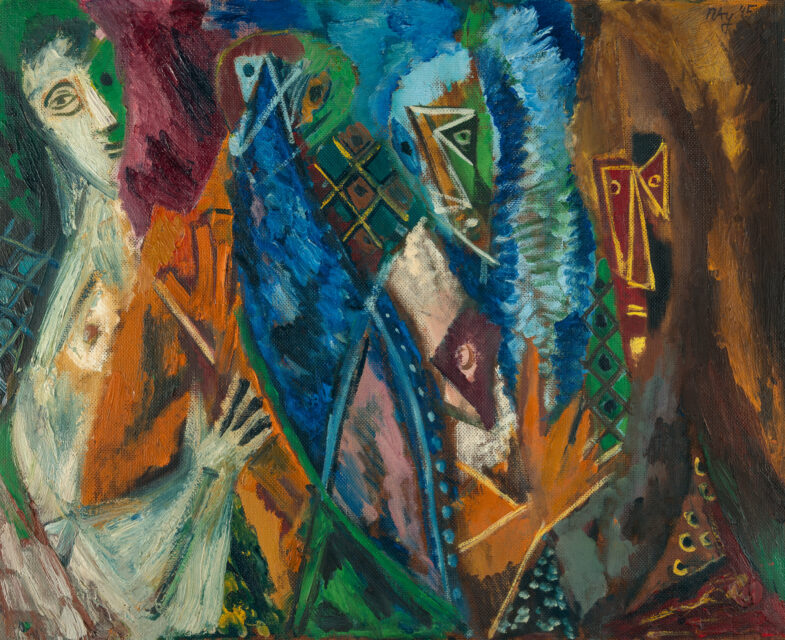“Der Vogelmensch und andere” (The bird man and others)
Details
Scheibler 339. Literature: Haftmann, Werner, E. W. Nay, Cologne 1991 (new and extended edition), p. 118; Weltzien, Friedrich, E. W. Nay – Figur und Körperbild. Kunst und Kunsttheorie der vierziger Jahre, Berlin 2003, p. 200. Exhibitions: E. W. Nay, Galerie Günther Franke, Munich 1946, cat. no.18;Ernst Wilhelm Nay, Galerie Axel Vömel/Kunstkabinett Hans Trojanski, Düsseldorf 1947, cat. no.12;E. W. Nay. Gemälde, Aquarell, Guasch (sic), Zeichnung, Kunstverein, Hamburg/Overbeck-Gesellschaft im Behnhaus, Lübeck 1947, cat. no.42; E. W. Nay. Arbeiten der Jahre 1924-1952, Haus am Waldsee, Berlin 1952, cat. no.88; Deutscher Künstlerbund Neunte Ausstellung. Kunst und Mythos, Städtisches Museum, Wiesbaden 1959, cat. no.412, with ill.E. W. Nay. Bilder aus den Jahren 1935-1968, Museum Städtische Kunstcollection ofen, Bonn 1970, cat. no.11. Provenance: Collection of Eberhard Seel (1900-1978), Berlin/Cologne;Bassenge, Berlin 29.11.2003, lot 6924; private collection, Hessen.
Description
• Vivid painting from the period of the Hekate paintings
• Joyful and artistically hopeful testimony to the new start after the war
• From the collection of the art historian Eberhard Seel
“My paintings are highly colourful, using many tones, and very painterly – freely painted. I am currently taking a leap forwards.” Ernst Wilhelm Nay, 1945 The period of work in which Nay created the Hekate pictures, whose name was coined by Ernst Gosebruch, the artist’s long-time friend and mentor, covers the years 1945 to 1948 and marks Nay’s new artistic beginning after the war. Nay was released after a short period of captivity in May 1945, immediately after the end of the war, but Berlin was in ruins and his apartment and studio had been bombed. He moved to Hofheim am Taunus, where, thanks to Hanna Bekker, he was able to use the former studio and house of the painter Ottilie W. Roederstein. The name Hekate is derived from the two paintings “Daughter of Hekate” I and II from 1945 and 1946 (see WVZ Scheibler 337 and 366). In Greek mythology, the sorceress Hekate is the goddess of magic, crossings and forks in the road and guardian of the gates between worlds. “For Nay, the end of the war did not signify an “hour zero”, but rather the longed-for freedom to finally continue, without impairment, the work that was only created sporadically and in secret during the Nazi dictatorship and war. The fears and horrors of the past, the internal and external devastation (…), personal experiences (…) mature in Nay’s imagination into images that express these shocks in abstract metaphors. The formal vocabulary of circles, spindles, chessboards and hands, which is common to all periods of Nay’s work, is visibly woven into encrypted figures and landscapes in the Hekate pictures. Eruptive or restrained, painted in thick impasto in dark or pastel colour palettes, the Hekate paintings reflect the tragedy and emerging hope of the post-war period. In their artistic mastery they simultaneously dissolve all distress. (…) In a series of solo exhibitions in quick succession (…), Nay’s Hekate pictures became known and understood surprisingly quickly for their originality and charisma. In those tense, lively years after 1945, having just escaped the chaos of the past, a primed public sensed the timeliness of these images.” (Elisabeth Nay-Scheibler, Ernst Wilhelm Nay. Werkverzeichnis der Ölgemälde, vol. I, Cologne 1990, p. 224).The painting comes from the collection of the art historian Eberhard Seel (1900-1978). He runs the Reitzenstein & Seel gallery in Berlin with his wife Alexandra von Reitzenstein. From 1950 to 1972 he was managing director and from 1966 a member of the board of the German Artists’ Association. He is a close friend of the artist Werner Heldt, whose estate he manages and whose oeuvre he published in a catalogue raisonné in 1976.
* All results incl. buyer’s premium (27%) without VAT. No guarantee, subject to error.
** All post-auction prices excl. buyer's premium and VAT. No guarantee, subject to error.
*** Conditional Sale: The bid was accepted below the limit. Acquisition of the work may still be possible in our post-auction sale.
R = regular taxation
N = differential taxation on works of art which originate from a country outside of the EU
The private or commercial use of images shown on this Website, in particular through duplication or dissemination, is not permitted. All rights reserved.


